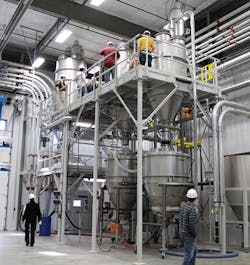Bulk Solids Innovation Center researches, teaches users to optimize material handling
Liquids and gases are easy—or at least their characteristics and behaviors are better understood. Granules, grains, pellets, powders and other particulate solids are more varied and less studied, so their profiles often remain mysterious and require further study to let users handle and process them with fewer problems and greater effectiveness.
That's the basic mission of the Bulk Solids Innovation Center (BSIC) at Kansas State University in Salina, Kan. The center is the result of a collaborative partnership of industry, education and government, and is reported to be the only university-level research facility of its kind in North America. It examines the properties of various bulk substances; tests them and how they're handled and conveyed; develops reports and solutions to improve storage and flow efficiency; and educates users and interns about how to improve productivity.
BSIC consists of a two-story 13,000-square-foot building with six laboratories for university- and industry-sponsored research, and training and conference rooms. Its laboratories include a material properties testing lab with a complete range of instruments and a full-scale, bulk solids testing bay (Figure 1). Its bulk solids processing systems can perform feeding, weighing and scaling, silo blending and segregation, particulate air filtration, gravity flows and flow aids. The center also has full-scale, dense- and dilute-phase, pneumatic conveying systems to research and solve issues related to bulk solids transport, such as attrition, segregation, sizing, wear and energy consumption.
Origins and challenges
Even though bulk solids account for 75-80% of the ingredients and products produced and transported worldwide, BSIC reports formal education and research are rare. The same goes for the persistent challenges presented by slurries of mixed liquids and solids, foams of differing consistencies and layers of gases and liquids in the same vessels.
"The center was organized about 10 years ago by a group of people from the agriculture, food, chemical, plastics and pharmaceutical manufacturers near here, who lamented there was no place to study and get educated about bulk solids because they weren't researched or taught at the universities, so they began working with Kansas State and local government," says Todd Smith, P.E., business and strategy manager at BSIC. "There are more resources for liquids and gases historically because users have worked with them longer and know the equations for dealing with them, and so they're simpler to quantify, present fewer variables and have more predictable solutions. So, even though there are more varieties of bulk solids, they're less studies and understood, many questions about them and their behavior aren't resolved, and there aren't predictable solutions for many of them."
After several years of organizing and securing funding, BSIC's founders built and opened the center five years ago, integrated equipment from 25 donor companies, and began studying the many variables associated with bulk solids. This research was especially needed because characteristics can vary if the same application is located at different sites according changes in ambient conditions and environments.
"For instance, we recently worked with a flame retardant that consisted of a sticky material that flowed and performed okay at one site but not at another,” says Kevin Solofra, lab manager at BSIC. “We had to ask if it was the setting, how the powder was processed, or if it was how operators were acting. Through testing and working with the customer, we discovered that the powder’s characteristic were highly dependent on the consolidation aspect of the material. In another test, we were able to reveal that a powder's characteristics varied based on storage humidity and temperature. So, even though particle size was consistent, the material flowed differently due to environmental conditions.
"Level measurement of bulk solids is also more challenging because filling and discharging often creates unusual angles and levels that shift, as well as dust in silos that can affect readings."
Research and services
Smith and Solofra report that BSIC conducts research in three primary areas:
- Storage and flow to typically investigate why products like sugar, clay, adipic acid, magnesium stearate and others initially flow properly from their hoppers, but don't come out an hour or day later;
- Air filtration for particulates to determine optimal filtering and dust collection strategies and solutions; and
- Conveying of bulk solids that poses problems for most users because it causes particle damage, which leads to segregation in mixes and subsequent performance problems.
"Many of these headaches were previously addressed with trial-and-error, rules of thumb, and doing what users did last time, instead of rigorous design based on what works best," says Solofra. "Another problem was that a lack of proper design could also lead solutions to be over-designed without addressing what an application really needed."
Because regular academic curricula still teach about liquids, gases and related equations—but not bulk solids—Smith explains one of BSIC's primary services is conducting its own short-courses every other month for about 100 students per year, who learn about bulk solids handling, flow and storage, and pneumatic conveying.
"We also have student interns, who get hands-on experience with bulk solids," says Raju Dandu, director of BSIC. "They help conduct experiments, manage projects and write reports, and are much better prepared to work in industry as a result."
Figure 2: Bulk solids processing systems at BSIC can perform feeding, weighing and scaling, silo blending and segregation, particulate air filtration, gravity flows and flow aid functions. The center also has full-scale, dense- and dilute-phase, pneumatic conveying system for researching issues related to bulk solids transport. Its test capabilities include particle size and distribution, particle shape, loose and compacted bulk density, particle density, angle of slide/repose, and moisture content. Source: BSIC
The center's second primary service area is material properties testing. Many of its clients, such as Dow, DuPont, Procter & Gamble and others, used to have more internal testing capability than they have now, so they bring flow, filter and conveying problems to BSIC. Its test capabilities include: particle size and distribution, particle shape, loose and compacted bulk density, particle density, angle of slide/repose and moisture content (Figure 2).
"We also measure flow functions and wall friction angles, cohesive strength, time consolidation, cohesion, internal friction, compressibility, aeration and permability," adds Solofra. "This is important because a lot of flow and bulk solids knowledge is phasing out as people retire, and it isn't being replaced."
The third main service is research and consultancy for clients seeking to avoid process shutdown due to increasingly scarce expertise, who ask BSIC to test individual formulations or evaluate how they can scale up their operations. "We've got bins, silos, hoppers, feeders, conveyors, and flow weighing, vibrating and aerating equipment," says Solofra. "This lets us complete four or five testing or consulting projects per month."
In one representative project, Solofra reports BSIC worked with a chemical company that makes an emulsifier, which is dry and sprayed into baking ingredients.
"The client complained that its emulsifier was potentially causing caking and clumping, instead of staying in powdered form. While the client was able to try different process steps and additives to find adequate flow aids, BSIC testing identified other potential, powder-related concerns. This allowed the company to look at their process for additional process improvements from a different point of view."
Bulk and level lessons learned
In the five years that BSIC has been researching and testing, Solafra reports he and his colleagues have learned that every bulk solids application is different, and must investigated thoroughly to determine what it needs for optimal performance.
"One week we'll work with kitty litter, next we'll have elastomer rubber pellets, and then it will be cow manure with lots of fiber. These and the hundreds of other solids we work with all have different characteristics and requirements, so it also helps that we're getting closer to doing more reliable modeling that can reflect their behavior," says Solafra. "One thing that goes across all the testing and research projects we've done is that anything we think we know about a substance must be verified. We can't trust or make assumptions."
Solafra adds that a typical project at BSIC starts with checking a solid's particle size because it may change or break during prior handling, or it may be affected by dust. Its profile density must also be examined because it can be linked to airflow in the process. "Once we verify these basic facts, the fun begins because we can begin to consult about why the substance isn't doing what the client wants," explains Solafra. "Common problems include lack of flow, clogging, caking, rat holing, and material bridging and arching over the discharge opening. This typically means using our moisture value test to check an application's temperature and humidity, which can make particles stick and get delayed like cars in heavy traffic. In addition, because Kansas is a high-humidity area, we have to compensate when doing certain projects like we did for an Arizona substation that had low humidity."
To achieve the best solutions for bulk solids challenges, Smith adds BSIC has two pieces of advice: "The sooner you get everyone in your company involved in understanding issues like flow problems, the better off you'll be. Operators know the most about their processes, and should be included, but they're often not as involved as they should be. Second, if you're changing or upgrading a process, investigate and consider its design factors upfront. Don't wait until a problem emerges later."
Modeling, simulation and the future
While its physical tests and experiments provide valuable bulk solids recommendations and know-how, Smith adds that BSIC also uses modeling software to conduct its research and identify solutions. These software packages include discrete element mode (DEM), finite element analysis (FEA) and computation fluid dynamics (CFD), which can help it examine flow patterns, stress distribution, velocity profiles and segregation patterns.
"We're using more software to study flow models of bulk solids, and answer questions like how long to agitate corn starch in a mixer," adds Smith. "These models can be difficult to use and aren't as reliable as they need to be yet, but we're trying to improve them, too."
Editor's note: The BSIC has partnered with Control's sister publication, Chemical Processing, to publish the BSIC Journal. The second issue is now available for download here.
About the Author

Leaders relevant to this article:



